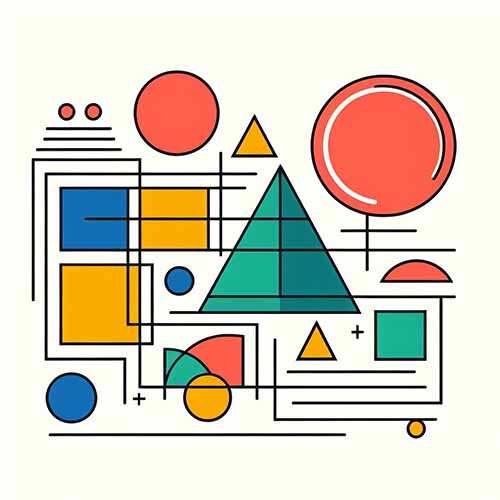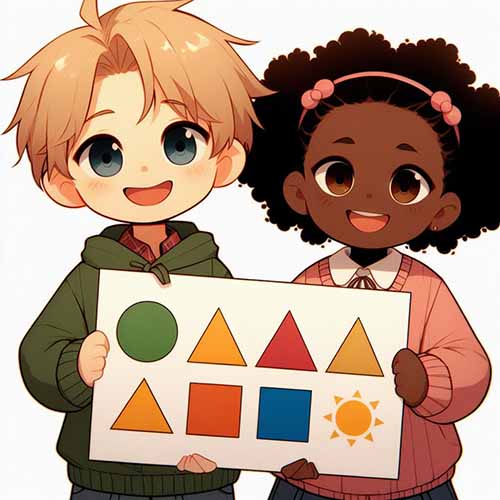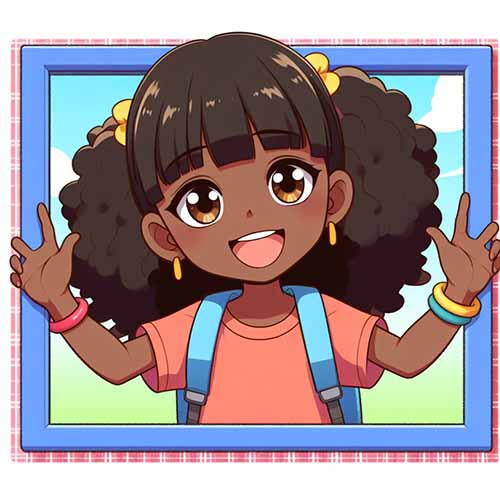Learning about Flat Shapes with Pre-Kinders and Kinders | Lesson Plans
-

Flat shapes line art - By BING -
Flat shapes are two-dimensional shapes that have no thickness. They are also called plane shapes or plane figures. Learning about flat shapes is essential to the math curriculum for pre-kinders and kinders. In these lesson plans, we will show you how to use MathSkills4Kids videos to teach and practice flat shapes fun and engagingly.
Furthermore, you will find some web and YouTube video links for more examples, games and engaging activities with kids.
Introduction: What are flat shapes, and how can we learn about them?
-
Flat shapes are shapes that can be drawn on a flat surface, such as paper or a board. They have sides, corners, and angles, but they do not have depth or volume. Some examples of flat shapes are circles, squares, triangles, and rectangles.
We can learn about flat shapes by observing them in our environment, reading books about them, watching videos that explain them, and making posters that show them.
-
FLAT SHAPES
-
BROWSE THE LESSON PLANS
-
-
Circles: How to use books, videos, and posters to introduce circles
A circle is a flat shape with one curved side and no corners. It is round and smooth. We can see circles in many things around us, such as wheels, clocks, coins, buttons, and fruits. To introduce circles to your students, you can use the following resources:
- Books: You can read some books that feature circles, such as The Dot by Peter H. Reynolds, Sir Cumference and the First Round Table by Cindy Neuschwander, or Shapes by John J. Reiss.
- Videos: You can watch some videos to practice circle recognition, such as MathSkills4Kids - Flat Shapes - Circle (https://www.mathskills4kids.com/flat-shapes-circle.php) or Sesame Street - The Shape of Things (https://www.youtube.com/watch?v=h3dRDjTzpQo).
- Posters: You can make some posters that show circles, such as a poster with different sizes and colors of circles, a poster with pictures of circular objects, or a poster with the word "circle" and its definition.
READ FURTHER
-
Squares: How to use books, videos, and posters to introduce squares
A square is a flat shape with four equal sides and four right angles. It has four corners that are all the same. We can see squares in many things around us, such as windows, tiles, books, boxes, and chess boards. To introduce squares to your students, you can use the following resources:
- Books: You can read some books that feature squares, such as Perfect Square by Michael Hall, Square by Mac Barnett and Jon Klassen, or Mouse Shapes by Ellen Stoll Walsh.
- Videos: You can watch some videos that help practice squares recognition, such as Which Shape is a Square (🔷)? Fun Shape Recognition for Prekindergarten and Kindergarten Math! (https://youtu.be/lA9XqYNrq10).
- Posters: You can make some posters that show squares, such as a poster with different sizes and colors of squares, a poster with pictures of square objects, or a poster with the word "square" and its definition.
-
Triangles: How to use books, videos, and posters to introduce triangles
Triangles are another type of flat shape that students can learn about. Triangles have three sides and three angles and can be of different sizes and orientations. To help students recognize and name triangles, you can use books, videos, and posters as teaching tools.
- Books: You can read books that feature triangles as characters or objects, such as The Greedy Triangle by Marilyn Burns or Triangle by Mac Barnett and Jon Klassen. These books can spark discussions about the properties and attributes of triangles and their similarities and differences with other shapes.
- Videos: You can also show videos to practice triangle recognition, such as the MathSkills4Kids video on triangles (https://www.youtube.com/watch?v=qVmiwge5QoU). You can pause the video at specific points to ask questions or check for understanding.
- Posters: Another way to reinforce the learning of triangles is to display posters that show different types of triangles, such as equilateral, isosceles, scalene, right, acute, and obtuse. You can also have students create their own posters by cutting out or drawing triangles and labeling them. These posters can serve as visual aids and reminders for students throughout the unit.
-
Rectangles: How to use books, videos, and posters to introduce rectangles
Rectangles are another familiar flat shape that students encounter in their everyday lives. Rectangles have four sides and four angles and are made of two pairs of parallel sides. To help students learn about rectangles, you can use books, videos, and posters as well.
- Books: You can read books that feature rectangles as characters or objects, such as The Perfect Square by Michael Hall or Rectangle Time by Pamela Paul and Becky Cameron. These books can help students appreciate the beauty and versatility of rectangles and their connection to other shapes, like squares.
- Videos: You can also show videos to practice rectangle recognition, such as the MathSkills4Kids video on rectangles (https://www.youtube.com/watch?v=O_T3pbbCUC8). You can pause the video at specific points to ask questions or check for understanding.
- Posters: Another way to reinforce the learning of rectangles is to display posters that show different types of rectangles, such as squares, oblongs, or parallelograms. You can also have students create their own posters by cutting out or drawing rectangles and labeling them. These posters can serve as visual aids and reminders for students throughout the unit.
Conclusion: How to summarize and evaluate what students learned about flat shapes
At the end of the unit on flat shapes, you can summarize and evaluate what students learned using various activities and assessments. Here are some ideas:
- Review flat shapes' main concepts and vocabulary using flashcards, games, or quizzes.
- Have students sort or classify different flat shapes according to their attributes or properties.
- Have students create patterns or designs using flat shapes.
- Have students compare and contrast flat shapes using Venn diagrams or charts.
- Have students apply their knowledge of flat shapes to solve problems or puzzles.
- Have students reflect on their learning process and progress using journals or portfolios.
Using these activities and assessments, you can help students consolidate their understanding of flat shapes and prepare them for more advanced topics in geometry.
Thank you for reading this page on how to teach flat shapes to kids using MathSkills4Kids videos. We hope you found it helpful and informative. If you have any questions or feedback, please contact us. Moreover, do not forget to subscribe to our channel for more fantastic math videos for kids!
Please CLICK THE SHARE BUTTON to allow others to benefit from this content!
Happy teaching!





